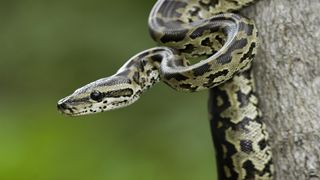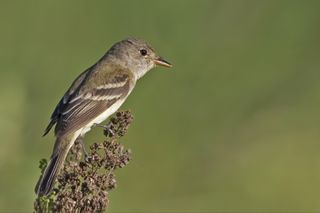What are invasive species?
Global trade is bringing invasive species to new environments around the world. Is that always a bad thing?

An invasive species is a type of animal, plant, fungus or any other living thing that has arrived in a new environment and can harm other species there.
You might hear the term "invasive species" used interchangeably with "naturalized species," "exotic species," "noxious species" and "non-native species." Although each of these terms has a slightly different meaning, they all refer to members of a species living in an area they aren't originally from. "An invasive species is almost always from somewhere else and there's concern that it could be harming the system," said Katharine Suding, an ecologist at the University of Colorado Boulder.
Species invasions are on the rise: Of all invasive species discovered during the past 200 years, about 40% were discovered after 1970, according to a study published in 2017 in the journal Nature Communications. Often, invasive species arrive in the new environment as people's pets, additions to someone's garden or stowaways on a boat.
Global trade regularly carries species to new places around the world, inadvertently or deliberately. A 2009 review in the Journal of Applied Ecology suggests that the recent upswing in invasions has been propelled by globalization, economic growth and more efficient international transportation. The countries with the highest number of invasive species include the United States, France, Australia and China, a 2016 study in the journal Global Ecology and Biogeography found.
Related: Would you eat a python to save the Everglades?
Why are invasive species a problem?
In 2010, scientists discovered Austropuccinia psidii, an invasive fungus from South America, in Australia. When the fungus spreads on Australia's eucalyptus trees, it takes over, stripping their branches of leaves, stunting their growth and sometimes killing them.
This fungus is an example of how invasive species can directly harm native species — in this case, by killing them. But other invasive species harm native species indirectly. For example, fish called bighead carp (Hypophthalmichthys nobilis) were brought to the United States from China in 1973 and now swim around the Mississippi River watershed, gorging on plankton. Plankton form the base of the watershed's food web, so when the carp eat the plankton, it results in a food shortage for small, native filter-feeding fish. When these small fish starve and subsequently disappear, so do the bigger fish that eat them. In this way, the carp create a nutrient shortage that ripples through the ecosystem, according to researchers at the University of Michigan.
Related: 'Crazy worms' have invaded the forests of 15 states, and scientists are worried
Other invasive species prey on native species or compete with them for water and habitat and, in doing so, threaten biodiversity (the variety of life in an ecosystem).
Invasive species can also cost people a lot of money. For example, new pests or pathogens can threaten crops and aquaculture. Invasive species management and damages have cost an average of $26.8 billion USD globally since 1970, according to a 2021 analysis published in the journal Nature. In response, conservationists, governments and land managers often attempt to mitigate damage caused by invasive species by eradicating them or keeping their populations low.
Are invasive species always bad?
By definition, invasive species can harm other species in their new environment, but that doesn't necessarily mean they will.
"Many invasions occur where the [invasive] species can't survive or do well in the new environment," Suding told Live Science. Of those that establish themselves in the new environment, some invasive populations will grow abundant, while others will remain small and innocuous, she added. In rare cases, invasive species may even benefit some members of their new environment.
Take the tamarisk, for example. This genus of Eurasian shrubs was introduced to the United States as an ornamental plant in the 19th century and has since spread throughout the western U.S. The tamarisk causes problems: It sucks up a lot of water and secretes salt into the ground, thereby preventing native trees from growing around it. However, an endangered bird called the southwestern willow flycatcher (Empidonax traillii extimus) has begun breeding and feeding on the tamarisk, at least since the 1990s, according to a 2008 report in the journal Restoration Ecology. In this case, the invasive shrub is hurting some native species while helping another, by providing habitat to a bird in need.

Climate change is altering the way ecologists think about invasive species because of the shifting habitat borders for many species, creating habitat in parts of the globe where some species might have previously been considered invasive. Species around the globe are moving uphill and toward the poles as average temperatures rise, a 2017 review published in the journal Science found. And mosquitoes' habitat is expanding latitudinally and into higher elevations, putting more people at risk of diseases these insects carry, such as dengue and yellow fever, according to a 2019 study in the journal Nature Microbiology. Even though species pushed into a new environment by climate change fit the traditional criteria for invasive species, some ecologists give them their own designation: range-shifters.
Related: Monstrous 'murder hornets' have reached the US
Some ecologists have pushed back on the notion that invasive species always threaten ecosystems. A 2011 commentary by 19 ecologists, published in the journal Nature, argued that natural landscapes are changing permanently due to factors such as climate change, deforestation, land use practices and urbanization and, therefore, that conservationists should change the way they manage species. Rather than judging a species based on where it originated, the authors wrote, conservationists should focus on how species function in an environment, taking into account both the good and the bad.
In some ways, this new mindset is already taking hold. As native ranges shift and expand, conservationists have begun facilitating some species' transitions to new environments, rather than trying to eradicate them in the new areas, Suding said. Some conservationists have even moved species to new habitats on purpose, in a bid to help them survive in an altered global climate — a process called assisted migration.
Ways to manage and exterminate invasive species
When conservationists decide what to do about an invasive species, they perform a sort of triage, prioritizing species based on the threat they pose and how hard it will be to eradicate or manage them. In some cases, that leads to an all-out eradication effort; in others, conservationists try to keep the population of the invasive species low enough that it poses minimal danger.
In 2005, conservationists completed a four-year mission to eradicate 80,000 feral goats that roamed the Galápagos Islands. The goats had been brought to the archipelago about a century earlier and had spent decades grazing the vegetation, causing erosion and competing with tortoises for food and habitat. Goat cullers tracked them down with helicopters, corralled them and killed them — an operation that cost more than $6 million, according to a 2009 article published in The Journal of Wildlife Management. This large-scale eradication effort was considered a success, with vegetation rebounding after a couple of years, the researchers said in a 2011 study published in the journal PLOS One.

In 2009, researchers attempted to use crab traps to eradicate European green crabs (Carcinus maenas) from a lagoon in California. But the effort proved futile; after the team removed 90% of the crabs, the population more than doubled by the following year. Adult crabs eat their young, and the researchers had removed most of the adults, leaving the juvenile population unchecked, the researchers wrote in a 2021 study published in the journal Proceedings of the National Academy of Sciences. Now, conservationists use a less aggressive strategy, keeping the crab population low enough to protect native species without attempting to eradicate them.
Recently, conservationists tested some creative strategies for managing invasive species. The U.S. Department of Agriculture tried to control the invasive tamarisk by releasing another non-native genus: leaf-eating beetles (Diorhabda spp.). In Florida, where invasive lionfish harm coral reefs, chefs have added the fish to their menus and fishers compete for prizes in lionfish derbies. These strategies have yielded mixed results. In the case of lionfish, studies have found that fishing can temporarily shrink their populations, but some ecologists warn that creating a market for lionfish might discourage conservation in the long run.
Related: The voracious and invasive lionfish is taking over the Atlantic. Here's why.
The best time to eradicate a dangerous invasive species is shortly after it has arrived, when it has been spotted once or twice, Suding said. "Once a species gets really abundant," she said, "you can imagine it's super hard to eradicate it."
Additional resources
- Learn about invasive species in your area with the Global Invasive Species Database, managed by the International Union for Conservation of Nature.
- Find ways to prevent the spread of invasive species on the U.S. Department of Agriculture website.
- Read the latest invasive species research in the journal Nature.
Sign up for the Live Science daily newsletter now
Get the world’s most fascinating discoveries delivered straight to your inbox.

Jen Monnier is a journalist in Seattle covering the environment and public health. Her work has appeared in Scientific American, CityLab, the Los Angeles Times, Hakai Magazine and Ensia. She earned her master's degree in science, health, and environmental reporting at New York University and a bachelor's degree in philosophy from Western Washington University.
